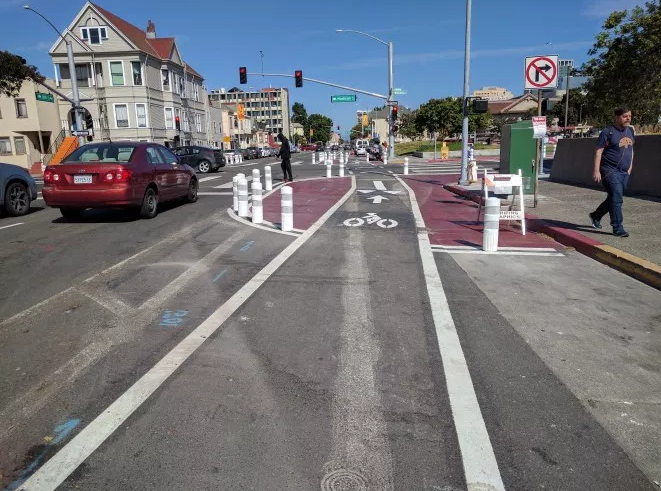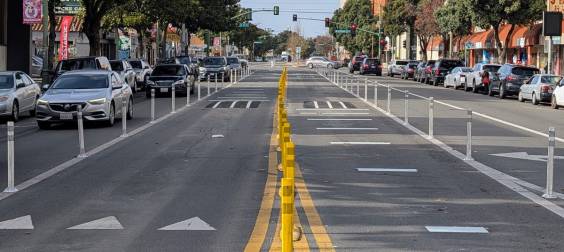Note: GJEL Accident Attorneys regularly sponsors coverage on Streetsblog San Francisco and Streetsblog California. Unless noted in the story, GJEL Accident Attorneys is not consulted for the content or editorial direction of the sponsored content.
The City of Oakland finished installing bollards on its new protected intersections and pedestrian bulb outs around the Lake Merritt BART station last week. And so far, they seem to be working as planned, slowing turning traffic, making it easier for Oakland Chinatown's large elderly population to cross the street, as well as offering safer crossings for cyclists.
Streetsblog watched a crew on Friday put in the last of the K71 bollards, which appear more robust than the safe-hit posts generally favored in San Francisco. They're installed by drilling a hole in the asphalt and then filling the hole with epoxy. A threaded mount is then inserted into the hole and, after it dries, the bollard is bolted onto it--making replacement quick and easy. Streetsblog thanked the crew for doing the messy work. "Anything to help keep people safe--it's not fun to ride [a bike] through here," said one of the workers.
Meanwhile, San Francisco advocates were quick to point to the elephant in the room on their side of the Bay: if it's this easy and cheap to do protected intersections for bicycles in Oakland, why is SFMTA still doing "mixing zones," at intersections, which Dutch engineers have found are not as safe? (For that matter, why does Oakland continue to install mixing zones in other locations?)
Why do San Jose and Oakland have near-term protected bike intersections and @sfmta_muni won't even paint bike lanes through intersections? Lack of staffing? Lack of funding? Inability to read NACTO guidelines? Apathy? Lazy leadership? SF deserves better. https://t.co/xLyNkL1EHH
— Kyle Grochmal (@KCGrock) June 27, 2019
"Protected intersections work best when you are able to set the bikeway away from the right lane by a car length and when you are able to get turning vehicles to be close to perpendicular when crossing the bikeway," wrote Ben Barnett, spokesperson for SFMTA. "Some intersections are more conducive to this than others. We are planning to implement such a design for northbound 7th Street at Townsend Street as part of the quick build project going to public hearing July 9th and it will be evaluated along with the rest of the bikeway as part of our evaluation program."
Streetsblog also has a request in to Oakland's DOT to find out if protected bike lanes will be added around Lake Merritt BART. However, OakDOT's Nicole Ferrara had previously explained that it's a money issue, and as developments go in around Lake Merritt BART, they may be able to get protected bike lanes funded as mitigation.
Meanwhile, if you follow Grochmal's Twitter exchange, there's also a bunch of neat videos and suggestions for minor improvements to the Lake Merritt treatments from Bike East Bay's Robert Prinz.
Streetsblog has a suggestion too--shortly after the posts were installed at 7th and Madison they were pretty much ruined by an incompetent and dangerous motorist(s). Maybe it's time to install something made out of steel and/or concrete, that can damage or disable a car? Maybe a concrete block next to the posts? Wouldn't that be better than allowing a motorist who is this dangerous to continue on their way, so they can mow down a person a mile or two farther down the street?
Let's hope longer-term improvements will depend more on concrete. Let us know your thoughts below.






